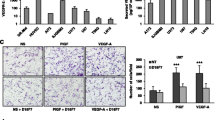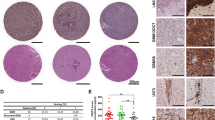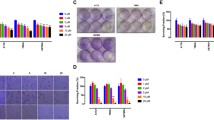Abstract
Bevacizumab is a humanized monoclonal antibody directed against the pro-angiogenic factor vascular and endothelial growth factor-A (VEGF-A) used in the treatment of glioblastomas. Although most patients respond initially to this treatment, studies have shown that glioblastomas eventually recur. Several non-mutually exclusive theories based on the anti-angiogenic effect of bevacizumab have been proposed to explain these mechanisms of resistance. In this report, we studied whether bevacizumab can act directly on malignant glioblastoma cells. We observe changes in the expression profiles of components of the VEGF/VEGF-R pathway and in the response to a VEGF-A stimulus following bevacizumab treatment. In addition, we show that bevacizumab itself acts on glioblastoma cells by activating the Akt and Erks survival signaling pathways. Bevacizumab also enhances proliferation and invasiveness of glioblastoma cells in hyaluronic acid hydrogel. We propose that the paradoxical effect of bevacizumab on glioblastoma cells could be due to changes in the VEGF-A-dependent autocrine loop as well as in the intracellular survival pathways, leading to the enhancement of tumor aggressiveness. Investigation of how bevacizumab interacts with glioblastoma cells and the resulting downstream signaling pathways will help targeting populations of resistant glioblastoma cells.












Similar content being viewed by others
Abbreviations
- CNS:
-
Central nervous system
- ECM:
-
Extracellular matrix
- HA:
-
Hyaluronic acid
- IgG1:
-
Immunoglobulin G1
- PlGF:
-
Placental growth factor
- VEGF:
-
Vascular and endothelial growth factor
References
Cao, Y., Zhong, W., & Sun, Y. (2009). Improvement of antiangiogenic cancer therapy by understanding the mechanisms of angiogenic factor interplay and drug resistance. Seminars in Cancer Biology, 19(5), 338–343. doi:10.1016/j.semcancer.2009.05.001.
Charles, N. A., Holland, E. C., Gilbertson, R., Glass, R., & Kettenmann, H. (2012). The brain tumor microenvironment. Glia, 60(3), 502–514.
Chauzy, C., Delpech, B., Olivier, A., Bastard, C., Girard, N., Courel, M. N., Creissard, P. (1992). Establishment and characterisation of a human glioma cell line. European journal of cancer (Oxford, England: 1990), 28A(6–7), 1129–1134.
Coquerel, B., Poyer, F., Torossian, F., Dulong, V., Bellon, G., Dubus, I., et al. (2009). Elastin-derived peptides: Matrikines critical for glioblastoma cell aggressiveness in a 3-D system. Glia, 57(16), 1716–1726. doi:10.1002/glia.20884.
David, L., Dulong, V., Le Cerf, D., Cazin, L., Lamacz, M., & Vannier, J.-P. (2008). Hyaluronan hydrogel: An appropriate three-dimensional model for evaluation of anticancer drug sensitivity. Acta Biomaterialia, 4(2), 256–263. doi:10.1016/j.actbio.2007.08.012.
David, L., Dulong, V., Le Cerf, D., Chauzy, C., Norris, V., Delpech, B., et al. (2004). Reticulated hyaluronan hydrogels: A model for examining cancer cell invasion in 3D. Matrix Biology: Journal of the International Society for Matrix Biology, 23(3), 183–193. doi:10.1016/j.matbio.2004.05.005.
De Groot, J. F., Fuller, G., Kumar, A. J., Piao, Y., Eterovic, K., Ji, Y., et al. (2010). Tumor invasion after treatment of glioblastoma with bevacizumab: Radiographic and pathologic correlation in humans and mice. Neuro-oncology, 12(3), 233–242. doi:10.1093/neuonc/nop027.
DeAngelis, L. M. (2001). Brain tumors. The New England journal of medicine, 344(2), 114–123. doi:10.1056/NEJM200101113440207.
Ellis, L. M., & Hicklin, D. J. (2008). Pathways mediating resistance to vascular endothelial growth factor-targeted therapy. Clinical Cancer Research: An Official Journal of the American Association for Cancer Research, 14(20), 6371–6375. doi:10.1158/1078-0432.CCR-07-5287.
Fan, F., Samuel, S., Gaur, P., Lu, J., Dallas, N. A., Xia, L., et al. (2011). Chronic exposure of colorectal cancer cells to bevacizumab promotes compensatory pathways that mediate tumour cell migration. British Journal of Cancer, 104(8), 1270–1277. doi:10.1038/bjc.2011.81.
Ferrara, N. (2009). VEGF-A: A critical regulator of blood vessel growth. European Cytokine Network, 20(4), 158–163. doi:10.1684/ecn.2009.0170.
Ferrara, N. (2010). Binding to the extracellular matrix and proteolytic processing: Two key mechanisms regulating vascular endothelial growth factor action. Molecular Biology of the Cell, 21(5), 687–690. doi:10.1091/mbc.E09-07-0590.
Ferrara, N., Hillan, K. J., & Novotny, W. (2005). Bevacizumab (Avastin), a humanized anti-VEGF monoclonal antibody for cancer therapy. Biochemical and Biophysical Research Communications, 333(2), 328–335. doi:10.1016/j.bbrc.2005.05.132.
Fischer, C., Jonckx, B., Mazzone, M., Zacchigna, S., Loges, S., Pattarini, L., et al. (2007). Anti-PlGF inhibits growth of VEGF(R)-inhibitor-resistant tumors without affecting healthy vessels. Cell, 131(3), 463–475. doi:10.1016/j.cell.2007.08.038.
Folkman, J. (1971). Tumor angiogenesis: Therapeutic implications. The New England Journal of Medicine, 285(21), 1182–1186. doi:10.1056/NEJM197111182852108.
Friedman, H. S., Prados, M. D., Wen, P. Y., Mikkelsen, T., Schiff, D., Abrey, L. E., et al. (2009). Bevacizumab alone and in combination with irinotecan in recurrent glioblastoma. Journal of Clinical Oncology: Official Journal of the American Society of Clinical Oncology, 27(28), 4733–4740. doi:10.1200/JCO.2008.19.8721.
Galas, L., Garnier, M., & Lamacz, M. (2000). Calcium waves in frog melanotrophs are generated by intracellular inactivation of TTX-sensitive membrane Na+ channel. Molecular and Cellular Endocrinology, 170(1–2), 197–209.
Grau, S., Thorsteinsdottir, J., von Baumgarten, L., Winkler, F., Tonn, J.-C., & Schichor, C. (2011). Bevacizumab can induce reactivity to VEGF-C and -D in human brain and tumour derived endothelial cells. Journal of Neuro-oncology, 104(1), 103–112. doi:10.1007/s11060-010-0480-6.
Hoelzinger, D. B., Demuth, T., & Berens, M. E. (2007). Autocrine factors that sustain glioma invasion and paracrine biology in the brain microenvironment. Journal of the National Cancer Institute, 99(21), 1583–1593. doi:10.1093/jnci/djm187.
Hong, X., Jiang, F., Kalkanis, S. N., Zhang, Z. G., Zhang, X.-P., DeCarvalho, A. C., et al. (2006). SDF-1 and CXCR4 are up-regulated by VEGF and contribute to glioma cell invasion. Cancer Letters, 236(1), 39–45. doi:10.1016/j.canlet.2005.05.011.
Jackson, A. P., Timmerman, M. P., Bagshaw, C. R., & Ashley, C. C. (1987). The kinetics of calcium binding to fura-2 and indo-1. FEBS Letters, 216(1), 35–39.
Keunen, O., Johansson, M., Oudin, A., Sanzey, M., Rahim, S. A. A., Fack, F., et al. (2011). Anti-VEGF treatment reduces blood supply and increases tumor cell invasion in glioblastoma. Proceedings of the National Academy of Sciences of the United States of America, 108(9), 3749–3754. doi:10.1073/pnas.1014480108.
Knizetova, P., Darling, J. L., & Bartek, J. (2008a). Vascular endothelial growth factor in astroglioma stem cell biology and response to therapy. Journal of Cellular and Molecular Medicine, 12(1), 111–125. doi:10.1111/j.1582-4934.2007.00153.x.
Knizetova, P., Ehrmann, J., Hlobilkova, A., Vancova, I., Kalita, O., Kolar, Z., & Bartek, J. (2008b). Autocrine regulation of glioblastoma cell cycle progression, viability and radioresistance through the VEGF-VEGFR2 (KDR) interplay. Cell cycle (Georgetown, Tex.), 7(16), 2553–2561.
Kwiatkowska, A., & Symons, M. (2013). Signaling determinants of glioma cell invasion. Advances in Experimental Medicine and Biology, 986, 121–141. doi:10.1007/978-94-007-4719-7_7.
Lee, S., Jilani, S. M., Nikolova, G. V., Carpizo, D., & Iruela-Arispe, M. L. (2005). Processing of VEGF-A by matrix metalloproteinases regulates bioavailability and vascular patterning in tumors. The Journal of Cell Biology, 169(4), 681–691. doi:10.1083/jcb.200409115.
Lee, J., Lee, J., Yu, H., Choi, K., & Choi, C. (2011). Differential dependency of human cancer cells on vascular endothelial growth factor-mediated autocrine growth and survival. Cancer Letters, 309(2), 145–150. doi:10.1016/j.canlet.2011.05.026.
Lucio-Eterovic, A. K., Piao, Y., & de Groot, J. F. (2009). Mediators of glioblastoma resistance and invasion during antivascular endothelial growth factor therapy. Clinical Cancer Research: An Official Journal of the American Association for Cancer Research, 15(14), 4589–4599. doi:10.1158/1078-0432.CCR-09-0575.
Mahesparan, R., Read, T.-A., Lund-Johansen, M., Skaftnesmo, K. O., Bjerkvig, R., & Engebraaten, O. (2003). Expression of extracellular matrix components in a highly infiltrative in vivo glioma model. Acta Neuropathologica, 105(1), 49–57. doi:10.1007/s00401-002-0610-0.
Masood, R., Cai, J., Zheng, T., Smith, D. L., Hinton, D. R., & Gill, P. S. (2001). Vascular endothelial growth factor (VEGF) is an autocrine growth factor for VEGF receptor-positive human tumors. Blood, 98(6), 1904–1913.
Mellinghoff, I. K., Lassman, A. B., & Wen, P. Y. (2011). Signal transduction inhibitors and antiangiogenic therapies for malignant glioma. Glia, 59(8), 1205–1212. doi:10.1002/glia.21137.
Miletic, H., Niclou, S. P., Johansson, M., & Bjerkvig, R. (2009). Anti-VEGF therapies for malignant glioma: Treatment effects and escape mechanisms. Expert Opinion on Therapeutic Targets, 13(4), 455–468. doi:10.1517/14728220902806444.
Moreno Garcia, V., Basu, B., Molife, L. R., & Kaye, S. B. (2012). Combining antiangiogenics to overcome resistance: Rationale and clinical experience. Clinical Cancer Research: An Official Journal of the American Association for Cancer Research, 18(14), 3750–3761. doi:10.1158/1078-0432.CCR-11-1275.
Nakada, M., Nakada, S., Demuth, T., Tran, N. L., Hoelzinger, D. B., & Berens, M. E. (2007). Molecular targets of glioma invasion. Cellular and Molecular Life Sciences: CMLS, 64(4), 458–478. doi:10.1007/s00018-007-6342-5.
Olsson, A.-K., Dimberg, A., Kreuger, J., & Claesson-Welsh, L. (2006). VEGF receptor signalling: In control of vascular function. Nature Reviews Molecular Cell Biology, 7(5), 359–371. doi:10.1038/nrm1911.
Plate, K. H., Scholz, A., & Dumont, D. J. (2012). Tumor angiogenesis and anti-angiogenic therapy in malignant gliomas revisited. Acta Neuropathologica, 124(6), 763–775. doi:10.1007/s00401-012-1066-5.
Pollo, B. (2012). Pathological classification of brain tumors. The Quarterly Journal of Nuclear Medicine and Molecular Imaging: Official Publication of the Italian Association of Nuclear Medicine (AIMN) [and] the International Association of Radiopharmacology (IAR), [and] Section of the Society of Radiopharmaceutical Chemistry and Biology, 56(2), 103–111.
Rahman, R., Smith, S., Rahman, C., & Grundy, R. (2010). Antiangiogenic therapy and mechanisms of tumor resistance in malignant glioma. Journal of Oncology, 2010, 251231. doi:10.1155/2010/251231.
Red-Horse, K., Crawford, Y., Shojaei, F., & Ferrara, N. (2007). Endothelium-microenvironment interactions in the developing embryo and in the adult. Developmental Cell, 12(2), 181–194. doi:10.1016/j.devcel.2007.01.013.
Stupp, R., Hegi, M. E., Mason, W. P., van den Bent, M. J., Taphoorn, M. J. B., Janzer, R. C., et al. (2009). Effects of radiotherapy with concomitant and adjuvant temozolomide versus radiotherapy alone on survival in glioblastoma in a randomised phase III study: 5-year analysis of the EORTC-NCIC trial. The Lancet Oncology, 10(5), 459–466. doi:10.1016/S1470-2045(09)70025-7.
Tabatabai, G., Weller, M., Nabors, B., Picard, M., Reardon, D., Mikkelsen, T., et al. (2010). Targeting integrins in malignant glioma. Targeted Oncology, 5(3), 175–181. doi:10.1007/s11523-010-0156-3.
Takano, S., Mashiko, R., Osuka, S., Ishikawa, E., Ohneda, O., & Matsumura, A. (2010). Detection of failure of bevacizumab treatment for malignant glioma based on urinary matrix metalloproteinase activity. Brain Tumor Pathology, 27(2), 89–94. doi:10.1007/s10014-010-0271-y.
Tate, M. C., & Aghi, M. K. (2009). Biology of angiogenesis and invasion in glioma. Neurotherapeutics: The Journal of the American Society for Experimental NeuroTherapeutics, 6(3), 447–457. doi:10.1016/j.nurt.2009.04.001.
Thompson, E. M., Frenkel, E. P., & Neuwelt, E. A. (2011). The paradoxical effect of bevacizumab in the therapy of malignant gliomas. Neurology, 76(1), 87–93. doi:10.1212/WNL.0b013e318204a3af.
Tuettenberg, J., Friedel, C., & Vajkoczy, P. (2006). Angiogenesis in malignant glioma: A target for antitumor therapy? Critical Reviews in Oncology/Hematology, 59(3), 181–193. doi:10.1016/j.critrevonc.2006.01.004.
Videira, P. A., Piteira, A. R., Cabral, M. G., Martins, C., Correia, M., Severino, P., et al. (2011). Effects of bevacizumab on autocrine VEGF stimulation in bladder cancer cell lines. Urologia Internationalis, 86(1), 95–101. doi:10.1159/000321905.
Vredenburgh, J. J., Desjardins, A., Herndon, J. E, 2nd, Dowell, J. M., Reardon, D. A., Quinn, J. A., et al. (2007). Phase II trial of bevacizumab and irinotecan in recurrent malignant glioma. Clinical Cancer Research: An Official Journal of the American Association for Cancer Research, 13(4), 1253–1259. doi:10.1158/1078-0432.CCR-06-2309.
Wade, A., Robinson, A. E., Engler, J. R., Petritsch, C., James, C. D., & Phillips, J. J. (2013). Proteoglycans and their roles in brain cancer. The FEBS Journal, 280(10), 2399–2417. doi:10.1111/febs.12109.
Watkins, S., & Sontheimer, H. (2012). Unique biology of gliomas: Challenges and opportunities. Trends in Neurosciences, 35(9), 546–556. doi:10.1016/j.tins.2012.05.001.
Wen, P. Y., & Kesari, S. (2008). Malignant gliomas in adults. The New England Journal of Medicine, 359(5), 492–507. doi:10.1056/NEJMra0708126.
Xu, T., Chen, J., Lu, Y., & Wolff, J. E. (2010). Effects of bevacizumab plus irinotecan on response and survival in patients with recurrent malignant glioma: A systematic review and survival-gain analysis. BMC Cancer, 10, 252. doi:10.1186/1471-2407-10-252.
Xu, L., Duda, D. G., di Tomaso, E., Ancukiewicz, M., Chung, D. C., Lauwers, G. Y., et al. (2009). Direct evidence that bevacizumab, an anti-VEGF antibody, up-regulates SDF1alpha, CXCR4, CXCL6, and neuropilin 1 in tumors from patients with rectal cancer. Cancer Research, 69(20), 7905–7910. doi:10.1158/0008-5472.CAN-09-2099.
Yamagishi, N., Teshima-Kondo, S., Masuda, K., Nishida, K., Kuwano, Y., Dang, D. T., et al. (2013). Chronic inhibition of tumor cell-derived VEGF enhances the malignant phenotype of colorectal cancer cells. BMC Cancer, 13(1), 229. doi:10.1186/1471-2407-13-229.
Zimmermann, D. R., & Dours-Zimmermann, M. T. (2008). Extracellular matrix of the central nervous system: From neglect to challenge. Histochemistry and Cell Biology, 130(4), 635–653. doi:10.1007/s00418-008-0485-9.
Acknowledgments
The authors would like to thank Catherine Buquet, Wiem Khelil, Laure Klosek, and Elisabeth Legrand for their technical help. The authors are very grateful to Dr. Flore Gouel and Pr. Isabelle Dubus for fruitful discussions. T. Simon is recipient of a fellowship from the “Conseil Régional de Haute-Normandie.” A. Petit is recipient of a fellowship from “Ministère de l’Enseignement supérieur et de la Recherche”.
Conflict of interest
The authors declare that they have no conflict of interest.
Author information
Authors and Affiliations
Corresponding author
Rights and permissions
About this article
Cite this article
Simon, T., Coquerel, B., Petit, A. et al. Direct Effect of Bevacizumab on Glioblastoma Cell Lines In Vitro. Neuromol Med 16, 752–771 (2014). https://doi.org/10.1007/s12017-014-8324-8
Received:
Accepted:
Published:
Issue Date:
DOI: https://doi.org/10.1007/s12017-014-8324-8




